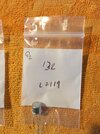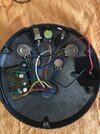Can anyone identify (manufacturer etc) these spare Ge Transistors i was given for my 1970's Dunlop JH-2 FuzzFace?
The two that were in the FzFc are a NKT275, and a B175; so the two spares are what im wondering about and they both look the same tho different engraving on top, see hand written note in pics.
Thanks.
The two that were in the FzFc are a NKT275, and a B175; so the two spares are what im wondering about and they both look the same tho different engraving on top, see hand written note in pics.
Thanks.
Attachments
-
 DE10AFF7-3647-4FE1-BBA1-C99A756F9E33.jpeg1.7 MB · Views: 1,061
DE10AFF7-3647-4FE1-BBA1-C99A756F9E33.jpeg1.7 MB · Views: 1,061 -
 C4822E5E-5B67-4244-9718-C9FC1A20AAB8.jpeg1.7 MB · Views: 995
C4822E5E-5B67-4244-9718-C9FC1A20AAB8.jpeg1.7 MB · Views: 995 -
 C0129D21-B4EE-4D33-8751-C4CFD10DAD23.jpeg1.1 MB · Views: 887
C0129D21-B4EE-4D33-8751-C4CFD10DAD23.jpeg1.1 MB · Views: 887 -
 9499C8A9-15A6-4A03-BFA5-CAF360B63C14.jpeg1.1 MB · Views: 1,007
9499C8A9-15A6-4A03-BFA5-CAF360B63C14.jpeg1.1 MB · Views: 1,007 -
 0F67B6BE-3A6D-4FB7-9A45-DC47A98EEB89.jpeg1.1 MB · Views: 942
0F67B6BE-3A6D-4FB7-9A45-DC47A98EEB89.jpeg1.1 MB · Views: 942





